Imagine turning a simple pound of ground beef into a journey to Seoul’s lively streets. Korean beef bowls offer a unique taste that shows gourmet food doesn’t need to take hours. With just 30 minutes, you can enjoy a meal that brings Korean flavors to your home.
Weeknight dinners can be both fun and simple. Korean beef bowls mix lean ground beef with bold Asian tastes. This creates a dish that’s healthy and very satisfying. The secret is using 93/7 lean ground beef and a few pantry items to make an amazing meal.
Key Takeaways
- Korean beef bowls are quick and easy to prepare
- Perfect for busy weeknight dinners
- Requires minimal cooking skills and time
- Offers authentic Korean cuisine experience
- Nutritionally balanced and flavorful meal option
- Versatile dish that can be customized to taste
Introduction to Korean Cuisine’s Rich Heritage
Korean cuisine is a journey through time, filled with tradition and culture. It spans from ancient times to today. Korean food has grown into a colorful mix of flavors, techniques, and ingredients. It shows the strength and creativity of the Korean people.
A vibrant, immersive scene showcasing the rich cultural heritage of traditional Korean cuisine. In the foreground, a skilled chef meticulously prepares a selection of authentic Korean dishes, the warm glow of a wood-fired stove illuminating the intricate details of the cooking process. The middle ground features an array of traditional Korean cookware, including brass pots, ceramic bowls, and wooden utensils, arranged against a backdrop of hand-painted screens and vibrant textiles. In the distance, a panoramic view of a lush, mountainous landscape infuses the scene with a sense of tranquility and connection to the land. The overall mood is one of reverence for the centuries-old culinary traditions that have shaped the unique flavors and techniques of Korean cuisine.
Traditional Korean Flavors and Ingredients
Korean cuisine is known for its unique taste. Bulgogi, a marinated beef dish, is a key example of Korean cooking’s depth. Traditional ingredients include:
- Soy sauce
- Sesame oil
- Garlic
- Ginger
- Korean pear (as a natural tenderizer)
The Evolution of Korean Rice Bowls
Rice bowls in Korean cuisine are more than food. They show the history and culture of Korea. Bulgogi and other marinated beef dishes have a long history, dating back to the Joseon Dynasty.
| Historical Period | Culinary Development |
|---|---|
| Goguryeo Era (37 BC–668 AD) | Origin of meat skewering techniques |
| Joseon Dynasty (1392–1897) | Refinement of neobiani meat preparation |
| Modern Era | Global popularity of Korean beef dishes |
Cultural Significance of Bowl Meals
Korean rice bowls are a cultural symbol. They are more than just food. A traditional meal includes many side dishes, with kimchi in almost every one. This way of eating focuses on balance, nutrition, and sharing, making a simple meal into a special experience.
Essential Ingredients for Authentic Korean Beef Bowls
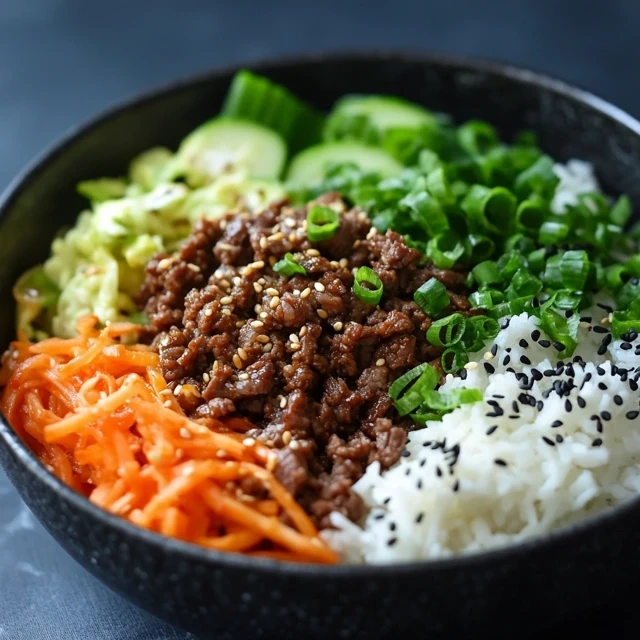
A bountiful array of Korean beef bowl ingredients arranged on a wooden table, bathed in warm, diffused natural light. In the foreground, juicy strips of marinated beef, garlic cloves, scallions, and daikon radish slices. Surrounding them, white rice, toasted sesame seeds, and a small bowl of gochujang sauce. In the middle ground, a ceramic bowl, chopsticks, and a wooden spoon, hinting at the preparation and presentation of this authentic Korean dish. The background softly blurs, emphasizing the focus on the essential components that come together to create a mouthwatering Korean beef bowl.
To make a real Korean beef bowl, you need the right ingredients. They add depth and excitement to your meal. Start by picking top-quality items that make ground beef taste amazing.
Here are the key ingredients for your Korean beef bowl:
- Lean ground beef (93% lean recommended)
- Low sodium soy sauce for authentic umami flavor
- Sesame oil for rich, nutty undertones
- Fresh garlic and ginger
- Gochujang (Korean red chili paste)
- Light brown sugar
- Crushed red pepper flakes
The secret to Korean beef bowls is balancing flavors. Soy sauce adds saltiness, and sesame oil gives a unique smell. Gochujang adds heat and depth, making your meal unforgettable.
If you have dietary needs, there are alternatives:
- Ground turkey
- Ground chicken
- Plant-based options like Beyond Beef
- Crumbled tofu
Adding sautéed mushrooms, bok choy, and edamame makes your bowl healthier and tastier.
Pro tip: Always use fresh ingredients and adjust seasonings to your taste preferences!
The Art of Marinating Korean Beef
Learning to marinate beef perfectly is key for a true Korean beef stir-fry. This process turns regular ground beef into a dish full of flavor. It makes your cooking at home even better.
Your marinade is what makes simple beef into a dish you’ll remember. Let’s look at what makes Korean beef marinades stand out.
Classic Bulgogi Marinade Components
A traditional Korean beef marinade has:
- 2 tablespoons low sodium soy sauce
- 2 tablespoons rice wine
- 2 teaspoons sesame oil
- 1 tablespoon honey
- 2 tablespoons minced fresh ginger
Tenderizing Techniques for Perfect Beef
To tenderize your beef, you need to be careful. Ground beef should be mixed gently and not overworked. For the best results, mix the marinade gently and let the beef soak up the flavors for 15-20 minutes before cooking.
Marination Timing and Tips
When making a beef stir-fry, timing is crucial. A quick 20-30 minute marination is perfect. It lets flavors in without making the meat tough. A tip: Mix brown sugar and Gochujang for extra flavor – use 3 tablespoons of each for the right heat.
For a great Korean beef bowl, a good marinade is essential. It brings out the rich, complex flavors of your ingredients.
Step-by-Step Cooking Instructions
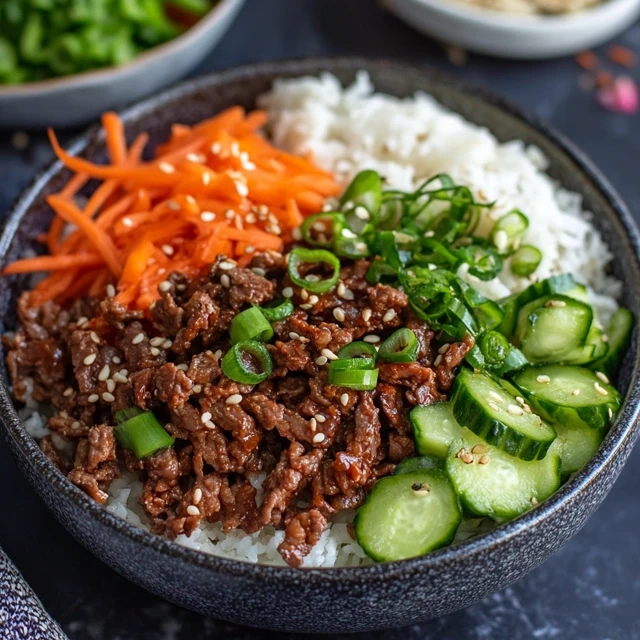
Making delicious Korean beef bowls is simple. This beef stir-fry recipe turns your kitchen into a Korean food haven in just 30 minutes. Here’s how to do it step by step.
- Prepare Your Ingredients
- Gather 1 lb ground beef
- Measure 4 tablespoons low-sodium soy sauce
- Mince 3 cloves of garlic
- Chop ¾ cup onions
- Cooking the Beef
- Heat a large skillet over medium-high heat
- Add 2 tablespoons olive oil
- Brown ground beef for 8-10 minutes
- Break meat into small pieces while cooking
- Creating the Sauce
- Mix soy sauce, brown sugar, and minced garlic
- Add sauce to browned beef
- Simmer for 3-4 minutes
Your Korean beef bowls are almost ready! The secret to a great beef stir-fry is getting the flavors just right. You want the meat to have a glossy, caramelized coat that will make your taste buds happy.
Pro tip: Add sliced green onions and a sprinkle of sesame seeds to make your Korean beef bowls even better. Serve them over steamed rice or cauliflower rice for a full meal.
Korean Beef Bowls: Building the Perfect Bowl
Making delicious rice bowls is like an art. It’s all about mixing flavors, textures, and looks. Korean beef bowls are a tasty treat you can make at home. The secret to a great bowl is in how you prepare and put it together.
Rice Selection and Preparation
Start with the right rice. Korean beef bowls usually use white rice. But, you can also try:
- Basmati rice for a fragrant base
- Jasmine rice for authentic Asian flavor
- Cauliflower rice for a low-carb option
Meat Preparation and Cooking
For the best Korean beef, follow these steps:
- Choose 85% lean ground beef for the best browning
- Use a 12-14 inch skillet for the best results
- Let the beef rest undisturbed for 2-3 minutes when browning
Assembly Techniques
When you build your Korean beef bowl, get creative. Layer your ingredients to make a meal that looks and tastes great.
| Layer | Recommended Ingredients |
|---|---|
| Base | Rice or cauliflower rice |
| Protein | Seasoned Korean beef |
| Vegetables | Shredded carrots, cucumber, green onions |
| Garnish | Sesame seeds, lime wedges |
Pro tip: Make your Korean beef bowls your own. Change the spice and try new toppings. The best thing about these bowls is how you can make them your own!
Vegetable Accompaniments and Garnishes
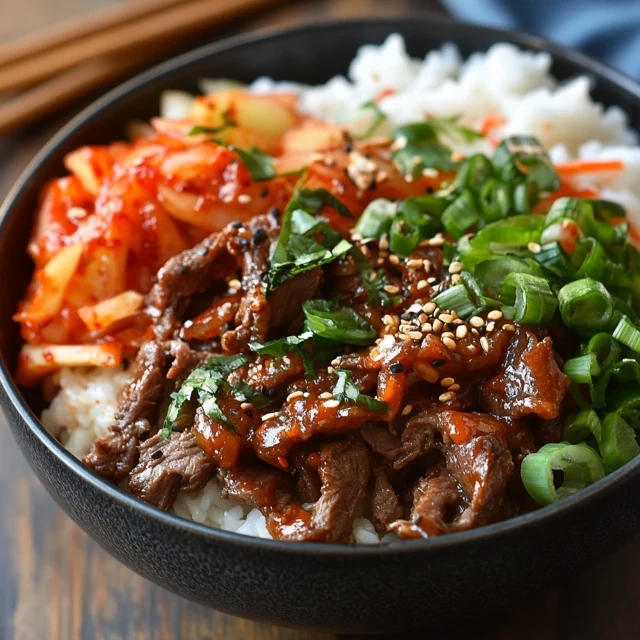
Make your Korean rice bowls more exciting with fresh veggies and creative garnishes. The right mix can turn a simple beef bowl into a feast for the eyes and taste buds.
Here are some top veggies to add to your Korean rice bowls:
- Fresh Vegetables: Start with 1 cup of mixed greens or cabbage
- Thinly sliced cucumber (¼ cup per serving)
- Shredded carrots (30g per bowl)
- Chopped bell peppers (3½ cups total)
For a true Korean touch, try these garnishes:
- Pickled radish
- Sautéed zucchini
- Roasted Brussels sprouts
- Sliced mushrooms
Turn your rice bowls into a canvas for creativity. Add sesame seeds, jalapeños, or sriracha for extra flavor. Mix and match to find your favorite taste.
Sauce Variations and Flavor Enhancements
Korean cuisine is full of vibrant sauces that can make your beef bowl amazing. Learning how to make these sauces will take your cooking to new heights. It will also bring real Korean flavors into your kitchen.
Traditional Gochujang-Based Sauces
Gochujang, a spicy chili paste, is key in many Korean sauces. It adds depth and complexity to your Korean beef bowls. To make a classic gochujang sauce, mix:
- 2 tablespoons gochujang
- 1 tablespoon soy sauce
- 1 teaspoon sesame oil
- 1 tablespoon honey
Modern Fusion Alternatives
Try new sauce combinations to expand your taste. Sriracha mayo is a hit, adding a creamy, spicy touch. Mix 1/2 cup mayonnaise with 2 tablespoons Sriracha for a delicious sauce.
Customizing Heat Levels
Everyone likes different levels of heat. You can change your sauce’s spiciness by adjusting the gochujang or adding red pepper flakes. For milder sauces, use less chili paste. For spicier ones, add more.
Creating a great Korean beef bowl is all about balancing flavors. Try different sauces to find your favorite mix!
Health Benefits and Nutritional Information
Korean beef bowls are a tasty mix of nutrition and flavor. They are full of important nutrients that make for a balanced meal. Let’s look at what makes this dish so good for you.
- They are a great source of protein, with about 36g per serving.
- They have a moderate amount of fat, just 8g per serving.
- They are low in carbs, making them good for many diets.
Nutritional Highlights:
| Nutrient | Amount per Serving | % Daily Value |
|---|---|---|
| Calories | 268 | 13% |
| Total Fat | 8g | 13% |
| Protein | 36g | 72% |
| Cholesterol | 89mg | 30% |
| Sodium | 556mg | 24% |
Korean beef bowls are great for those who want a protein-rich meal. The lean beef has essential amino acids. The veggies, like cabbage, add more nutrients.
- Cabbage is rich in vitamins K, C, B6, and A.
- It has 2g of dietary fiber per serving.
- It’s low in calories.
Choose lean ground beef (90-93% lean) for better nutrition. You can keep leftovers in the fridge for up to 4 days or freeze for 3 months. This makes it a healthy and easy meal option.
Make-Ahead Tips and Storage Guidelines
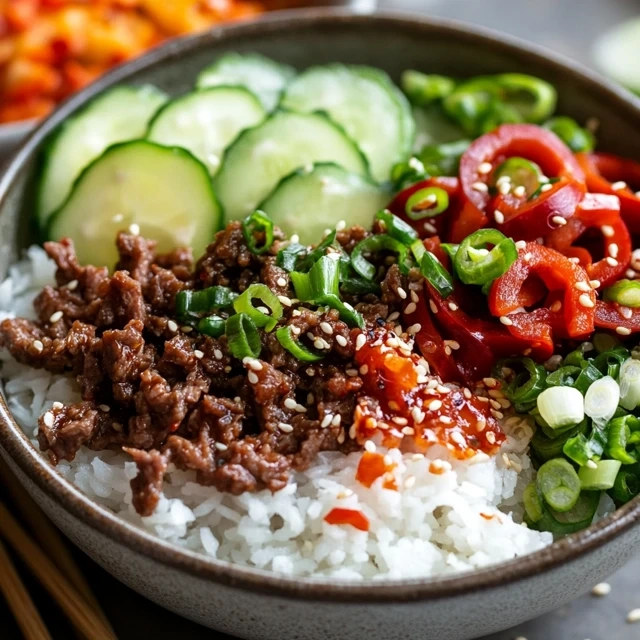
Korean beef bowls are great for those who love meal prep. They save time and let you enjoy tasty meals all week. With a few smart steps, your beef stir-fry can become easy-to-make dishes that still taste amazing.
Here’s how to store your Korean beef bowls for the best taste and convenience:
- Refrigerator storage: Store your Korean beef bowls in an airtight container for up to 5 days
- Freezer storage: Freeze your beef stir-fry in a proper package for up to 3 months
- Recommended container type: Use glass or BPA-free plastic containers with tight lids
For meal prep, follow these tips:
- Marinate beef early for better flavor
- Cook rice and store it separately from meat to keep it fresh
- Prepare veggies ahead and keep them in their own space
Pro tip: Store your Korean beef bowls in separate parts to avoid sogginess and keep each ingredient fresh.
Reheating your Korean beef bowls is easy. Microwave refrigerated parts for 1-1.5 minutes, stirring halfway. For frozen, thaw overnight in the fridge before heating.
Serving Suggestions and Presentation Ideas
Making the perfect Korean beef rice bowl is more than cooking. It’s about turning a meal into an adventure with the right presentation.
Traditional Korean Table Settings
In Korean cuisine, table settings show harmony and respect. When serving your Korean beef rice bowls, consider these traditional elements:
- Use small side dishes called banchan
- Arrange bowls symmetrically
- Include ceramic or stoneware dishes
- Place chopsticks and spoons carefully
Modern Plating Techniques
Make your Korean rice bowls look amazing with modern plating:
- Layer ingredients strategically
- Create color contrasts
- Use garnishes like sesame seeds
- Showcase marinated beef prominently
Complementary Side Dishes
Boost your Korean beef rice bowls with these great sides:
| Side Dish | Flavor Profile | Preparation Time |
|---|---|---|
| Kimchi | Spicy, Tangy | 5 minutes |
| Pickled Vegetables | Acidic, Crisp | 10 minutes |
| Korean Slaw | Fresh, Crunchy | 15 minutes |
Your Korean cuisine experience gets even better when you turn a simple rice bowl into a feast. It’s a mix of traditional flavors and modern creativity.
Conclusion
Korean beef bowls are a mix of convenience and flavor. They turn a simple weeknight meal into a special experience. With just 30 minutes of prep, you can make a tasty Korean dish using a pound of lean ground beef or bison.
These bowls are easy to make and versatile. By learning a few key techniques, you can improve your cooking. You’ll bring the lively flavors of Korean cuisine right to your table. They’re not only tasty but also packed with protein, healthy fats, and nutrients.
Exploring Korean beef bowls is an adventure in taste and creativity. Try out different marinades, garnishes, and sides to make each meal special. Whether you’re an experienced cook or just starting, these bowls are a great way to dive into Korean cooking.
Your culinary journey is just starting. It’s time to explore the amazing world of Korean cuisine. Enjoy the flavors, have fun, and make these delicious Korean beef bowls in your kitchen.
Free Body Calculator – Know Your Body
Wondering if your body is in a healthy range? Use our Free Body Calculator to find out if you’re fit, normal, or need a lifestyle change. Get personalized tips, calorie targets, and your ideal protein, carbs, and fat intake – all in seconds.
Try Free Body Calculator Now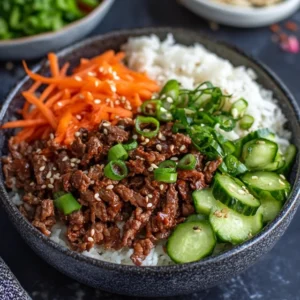
Easy Korean Beef Bowls – A 15-Minute Weeknight Dinner
Ingredients
- For the Beef:
- 1 tbsp sesame oil
- 1 lb ground beef or ground turkey
- 3 cloves garlic minced
- 1 tsp fresh ginger grated
- ¼ cup low-sodium soy sauce
- 2 tbsp brown sugar or honey
- 1 tbsp gochujang Korean chili paste or sriracha (adjust to spice level)
- ½ tsp black pepper
- ¼ tsp red pepper flakes optional, for extra heat
- 1 tsp rice vinegar
- For Serving:
- 2 cups cooked white rice or brown rice
- 1 tbsp toasted sesame seeds
- 2 green onions sliced
- 1 small cucumber thinly sliced (optional, for crunch)
- 1 carrot shredded (optional)
Instructions
- Cook the Beef:
- Heat sesame oil in a large skillet over medium heat.
- Add ground beef, breaking it up with a spatula. Cook for 5-7 minutes until browned and fully cooked. Drain excess grease if needed.
- Make the Sauce:
- Stir in garlic and ginger, cooking for 1 minute until fragrant.
- Add soy sauce, brown sugar, gochujang, black pepper, red pepper flakes, and rice vinegar. Stir to coat the beef evenly. Simmer for 2-3 minutes until the sauce thickens slightly.
- Assemble the Bowls:
- Divide cooked rice into bowls.
- Spoon the Korean beef over the rice.
- Garnish with sesame seeds, green onions, cucumber, and shredded carrots.
- Serve And Enjoy!
- Serve hot and enjoy with a side of kimchi for an extra Korean touch!
Notes
- Spicy or Mild? Adjust gochujang or red pepper flakes to your spice preference.
- Low-Carb? Serve over cauliflower rice or in lettuce wraps.
- Make It a Meal! Add a fried egg on top for extra richness.
- Storage: Refrigerate in an airtight container for up to 4 days.
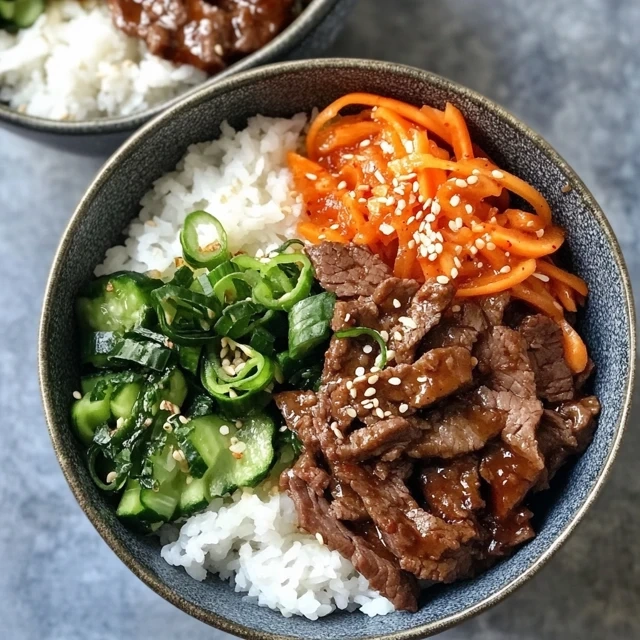

3 thoughts on “Easy Korean Beef Bowls – A 15-Minute Weeknight Dinner”
Comments are closed.